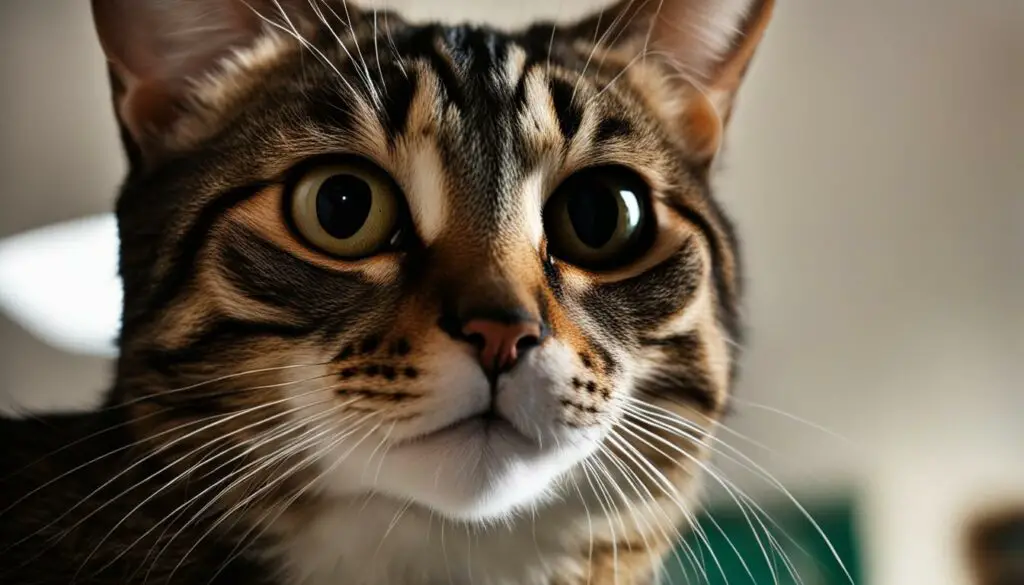Is your cat afraid of ceiling fans? You’re not alone. Many cats develop a fear of these spinning wonders, and it can leave us scratching our heads. In this article, I will explore the reasons why your cat may be scared of ceiling fans and provide tips on how to help them overcome their fear.
Key Takeaways:
- Many cats are afraid of ceiling fans due to their resemblance to flying predators.
- The sound and air movement generated by ceiling fans can contribute to feline anxiety.
- Negative experiences during installation may have caused a fear association.
- Desensitization, counter-conditioning, and altering the color of fan blades can help cats overcome their fear.
- Observe your cat for signs of fear such as dilated pupils, flattened whiskers, and crouched position.
Possible Reasons Why Cats Are Afraid of Ceiling Fans
There can be several possible reasons why cats may develop a fear of ceiling fans. One likely reason is that the movement and appearance of the fan blades resemble those of flying predators, such as birds of prey. This visual resemblance can trigger a fear response in cats, who instinctively perceive these predators as a threat.
In addition to the visual aspect, the sound and air movement generated by ceiling fans can also contribute to a cat’s anxiety. Cats have highly sensitive hearing, and the buzzing or squeaking noise produced by the fan can be unsettling for them. The breeze created by the fan may also be uncomfortable for cats, especially if they have difficulty regulating their body temperature.
Furthermore, sudden changes in light can be another factor that contributes to a cat’s fear of ceiling fans. The abrupt illumination from the fan’s light fixture can startle and disorient cats, leading to a heightened sense of fear and unease.
Table: Possible Reasons Why Cats Are Afraid of Ceiling Fans
| Reasons | Explanation |
|---|---|
| Visual Resemblance | The movement and appearance of fan blades can resemble flying predators, triggering a fear response. |
| Noise | The buzzing or squeaking noise produced by ceiling fans can be unsettling for cats with sensitive hearing. |
| Breeze | Cats may find the breeze created by ceiling fans uncomfortable, particularly if they struggle with body temperature regulation. |
| Sudden Changes in Light | The abrupt illumination from the fan’s light fixture can startle and disorient cats. |
Understanding these possible reasons behind a cat’s fear of ceiling fans can help cat owners implement appropriate strategies to help their feline companions overcome their anxiety. By addressing these factors and gradually acclimating cats to the presence of ceiling fans, it is possible to help them feel more comfortable and secure in their environment.
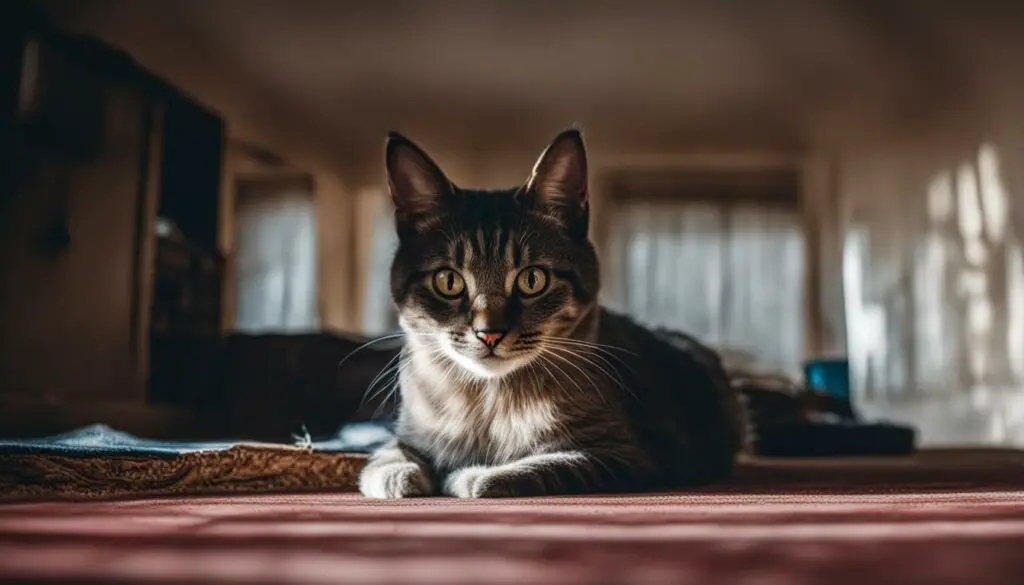
Signs that Your Cat is Scared of Ceiling Fans
Cats have subtle ways of expressing their fear and discomfort. When it comes to ceiling fans, there are specific signs that indicate your cat is scared. By being observant and attentive to your pet’s behavior, you can identify these signs and take appropriate measures to help them cope with their fear.
Recognizing the signs
There are several body language cues that indicate your cat is scared of ceiling fans. These include:
- Lowered and turned-out ears
- Flattened whiskers
- A crouched position with a slightly arched back
- Dilated pupils
These signs show that your cat is experiencing fear and anxiety in the presence of ceiling fans. Additionally, some cats may exhibit avoidance behavior, such as refusing to eat in rooms with ceiling fans.
Responding to your cat’s fear
It’s important to create a safe and secure environment for your cat when they are scared of ceiling fans. Provide them with a designated safe space where they can retreat to when they feel overwhelmed. This can be a cozy hiding spot or a comfortable bed away from the fan’s vicinity.
Additionally, avoid forcing your cat to confront their fear or punishing them for their anxiety. Instead, offer reassurance and support by providing treats, engaging in playtime, and offering gentle strokes. This positive reinforcement will help your cat associate positive experiences with the presence of the ceiling fan.
Remember, every cat is unique, and their comfort levels may vary. Be patient and understanding as you work with your cat to overcome their fear of ceiling fans.
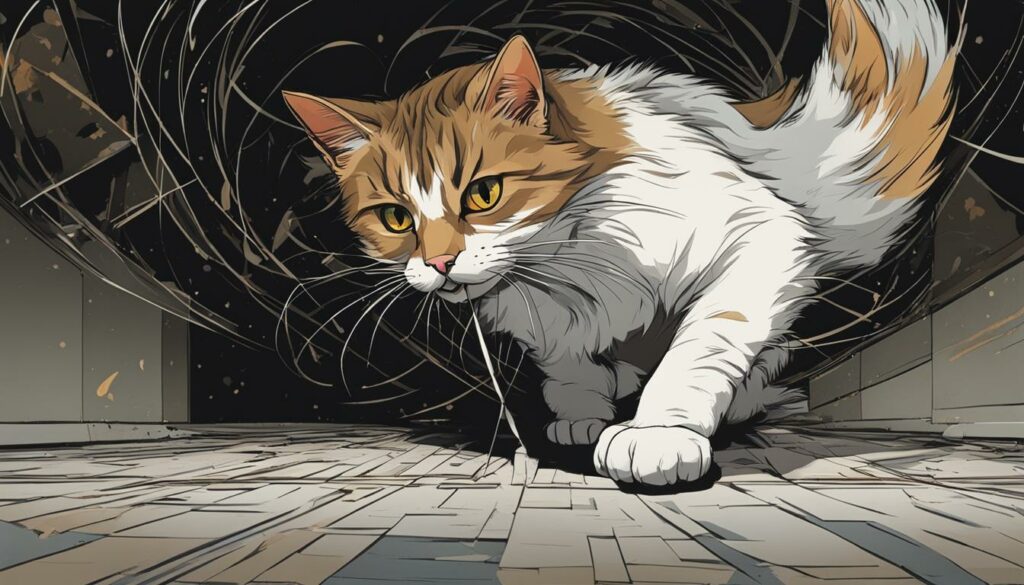
| Signs that Your Cat is Scared of Ceiling Fans | How to Help Your Cat |
|---|---|
| Lowered and turned-out ears | Create a safe space for your cat away from the ceiling fan |
| Flattened whiskers | Offer treats and engage in playtime to associate positive experiences with the fan’s presence |
| A crouched position with a slightly arched back | Provide reassurance and support through gentle strokes and comforting gestures |
| Dilated pupils | Be patient and understanding as you work with your cat to overcome their fear |
How to Calm Your Cat if it’s Afraid of Ceiling Fans?
If your cat is afraid of ceiling fans, there are several strategies you can try to help them feel calmer and overcome their fear. One effective approach is desensitization and counter-conditioning, which involves gradually exposing your cat to the fan while pairing it with positive experiences. Start by keeping the fan turned off and enticing your cat with treats or playtime near the fan. As your cat becomes more comfortable, slowly increase exposure by turning the fan on at the lowest speed. Be sure to reward your cat with treats and play whenever they display calm behavior around the fan.
Another technique you can use is altering the color of the fan blades to make them less visually intimidating. Consider using covers on the blades that match the color of the ceiling or the surrounding environment. This can help reduce the resemblance to flying predators and ease your cat’s anxiety.
Remember to always be patient and understanding with your cat as they work through their fear. Rushing the process or forcing your cat to confront their fear can make the situation worse. It’s crucial to create a safe and supportive environment where your cat feels secure.
In addition to desensitization and counter-conditioning, it’s important to provide your cat with a safe space away from the fan. This can be a designated room or area where your cat can retreat to if they feel overwhelmed. Creating alternative sources of airflow, such as a desktop fan, can also redirect their attention and provide comfort.
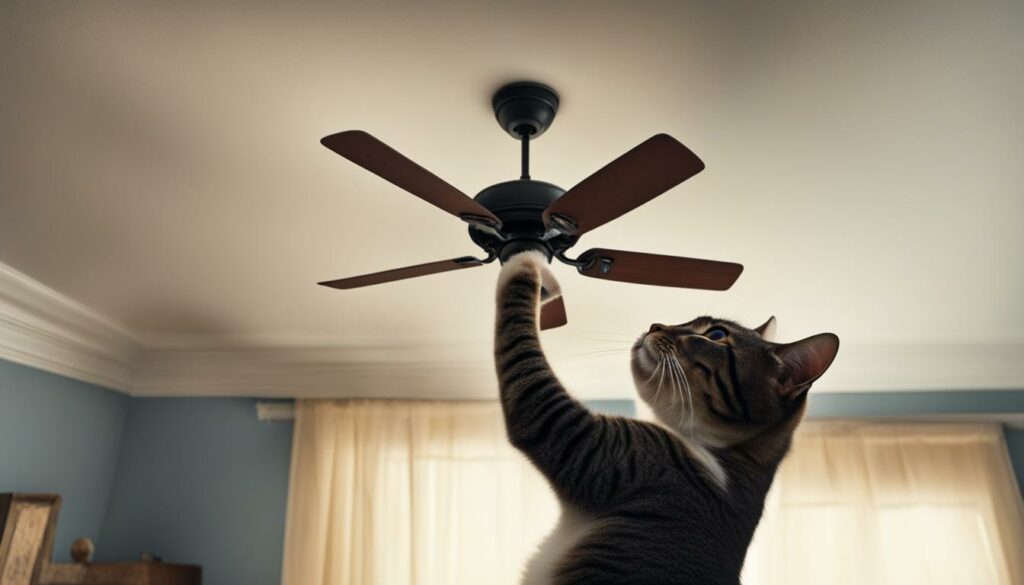
Summary:
- Use desensitization and counter-conditioning techniques to gradually expose your cat to the fan and pair it with positive experiences.
- Altering the color of the fan blades can help reduce their visual resemblance to predators and ease your cat’s anxiety.
- Create a safe and supportive environment for your cat, including a designated space away from the fan where they can feel secure.
- Provide alternative sources of airflow, such as a desktop fan, to redirect your cat’s attention and provide comfort.
By implementing these strategies and providing support and reassurance, you can help your cat overcome their fear of ceiling fans and create a more peaceful environment for them.
How to Know if Your Cat Feels Comfortable With Fans?
If you want to determine whether your cat feels comfortable with fans, there are several behavioral cues to look out for. Pay close attention to how your cat reacts when a fan is turned on. Some cats may show curiosity and approach the fan, while others may choose to stay at a distance. It’s important to observe their body language and overall behavior to gauge their comfort level.
A cat that feels comfortable with fans will exhibit relaxed body language. They may have their tail held up or sway gently from side to side. Normal eating habits are also a good indicator of their comfort, as stressed or scared cats may refuse to eat. If your cat doesn’t display signs of fear or stress, such as dilated pupils or flattened ears, they are likely comfortable with fans.
Every cat is unique, and their comfort levels may vary. Some cats may take longer to feel at ease, while others may never fully warm up to fans. It’s important to respect your cat’s individual preferences and not force them into uncomfortable situations. Ultimately, their well-being and happiness should be the top priority.
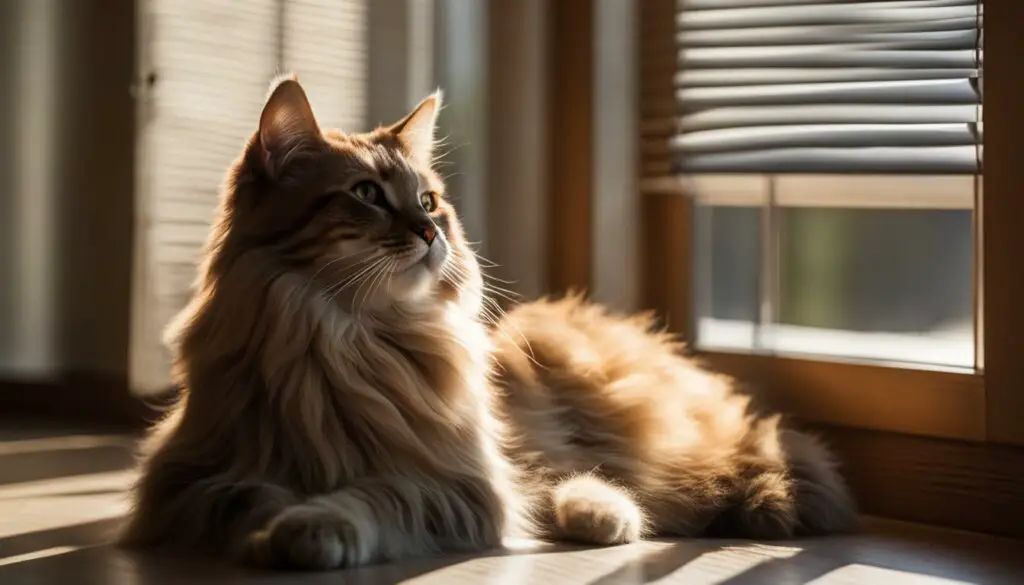
Signs of a Comfortable Cat:
- Relaxed body language
- Normal eating habits
- Absence of fear or stress signals (dilated pupils, flattened ears)
| Behavioral Cues | Comfort | Discomfort |
|---|---|---|
| Approaches the fan | Yes | No |
| Relaxed body language | Yes | No |
| Normal eating habits | Yes | No |
| No signs of fear or stress | Yes | No |
Remember, each cat is an individual, and their comfort and fear levels may differ. It’s important to observe and respect your cat’s boundaries when it comes to fans or any other potential stressors. If your cat shows signs of discomfort or fear, try implementing gradual desensitization techniques and provide them with a safe space where they can retreat if needed.
Possible Solutions for Cats Afraid of Ceiling Fans
If your cat is afraid of ceiling fans, there are several practical solutions you can try to help them feel more comfortable. Here are some possible strategies:
1. Alternative Airflow Source
Consider installing a desktop fan or providing another alternative source of airflow for your cat. This can redirect their attention and provide a sense of comfort without the fear-inducing aspects of a ceiling fan.
2. Separate Room
If possible, keep your cat in a separate room away from the ceiling fan when it is turned on. This can help reduce their fear and anxiety, allowing them to feel more secure in their environment.
3. Minimize Noise and Vibration
Stabilize the ceiling fan to minimize noise and vibration, which can make it less intimidating for your cat. This can be done by ensuring the fan is securely mounted and all components are properly tightened.
4. Controlled Exposure and Positive Reinforcement
Gradually acclimate your cat to the fan through controlled exposure and positive reinforcement. Start by turning off the fan and allowing your cat to explore and investigate it at their own pace. Pair their interactions with the fan with treats, praise, or playtime to create positive associations.
By implementing these possible solutions and being patient with your cat, you can help them overcome their fear of ceiling fans and create a more relaxed and comfortable environment for them.
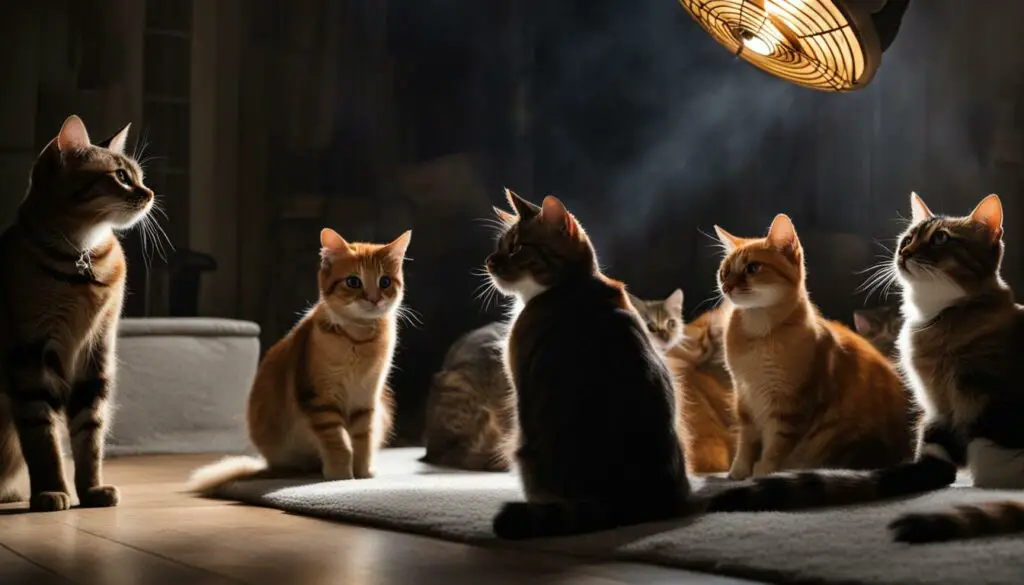
Tips for Helping Your Cat Overcome their Fear of Ceiling Fans
Helping your cat overcome their fear of ceiling fans requires patience, understanding, and a gradual approach. Here are some tips to help you navigate this process:
- Start by turning off the fan and creating a positive association: Begin by introducing treats and playtime near the fan to help your cat associate positive experiences with its presence. This will help them feel more comfortable in its vicinity.
- Gradually increase exposure and reward calm behavior: Slowly increase the exposure to the fan by moving the blades by hand, then turn it on at the lowest speed. Over time, gradually increase the speed while rewarding your cat with treats and play whenever they exhibit calm behavior around the fan.
- Respect your cat’s boundaries: Every cat is unique, and it’s important to respect their individual comfort levels. If your cat seems overwhelmed or shows signs of stress, take a step back and adjust the pace accordingly.
- Provide a safe space: Create a designated safe space for your cat away from the ceiling fan where they can retreat to when they feel anxious. This can be a cozy corner with their bed, toys, and familiar scents to help them feel secure.
Remember, consistency and positive reinforcement are key when helping your cat overcome their fear of ceiling fans. By taking small steps and providing a supportive environment, you can help your cat feel more comfortable and gradually conquer their fear.
“A gradual approach, patience, and positive reinforcement are essential when helping your cat overcome their fear of ceiling fans.” – Cat Lover
By following these tips and tailoring them to your cat’s unique needs, you can help them overcome their fear and create a stress-free environment in your home.
| Common Mistakes to Avoid |
|---|
| Forcing your cat near the fan or punishing them for their fear. This can worsen their anxiety and erode trust. |
| Neglecting to create a safe space for your cat away from the fan. Having a designated area where they feel secure is important for their mental well-being. |
| Rushing the process. Each cat is unique and may require more time to overcome their fear. Patience and understanding are key. |
How to Identify if Your Cat is Scared of Ceiling Fans?
If you suspect that your cat is scared of ceiling fans, there are certain signs and behaviors you can look out for. Cats may exhibit dilated pupils, flattened ears, a crouched position, and bristling fur when they are fearful of ceiling fans. These physical cues indicate that your cat is experiencing fear and discomfort in the presence of a ceiling fan.
In addition to these visual indicators, you may also notice changes in your cat’s behavior. They may attempt to avoid the room where the ceiling fan is located or display signs of anxiety such as excessive meowing or pacing. It’s important to pay attention to these signs and provide support and reassurance to help your cat feel more at ease.
The Signs That May Indicate Your Cat Is Scared of Ceiling Fans
| Physical Cues | Behavioral Changes |
|---|---|
| – Dilated pupils | – Attempts to avoid the room with the ceiling fan |
| – Flattened ears | – Excessive meowing |
| – Crouched position | – Pacing or restlessness |
| – Bristling fur |
By being observant of these signs and providing a safe and supportive environment, you can help your cat overcome their fear of ceiling fans and live a more comfortable and stress-free life.
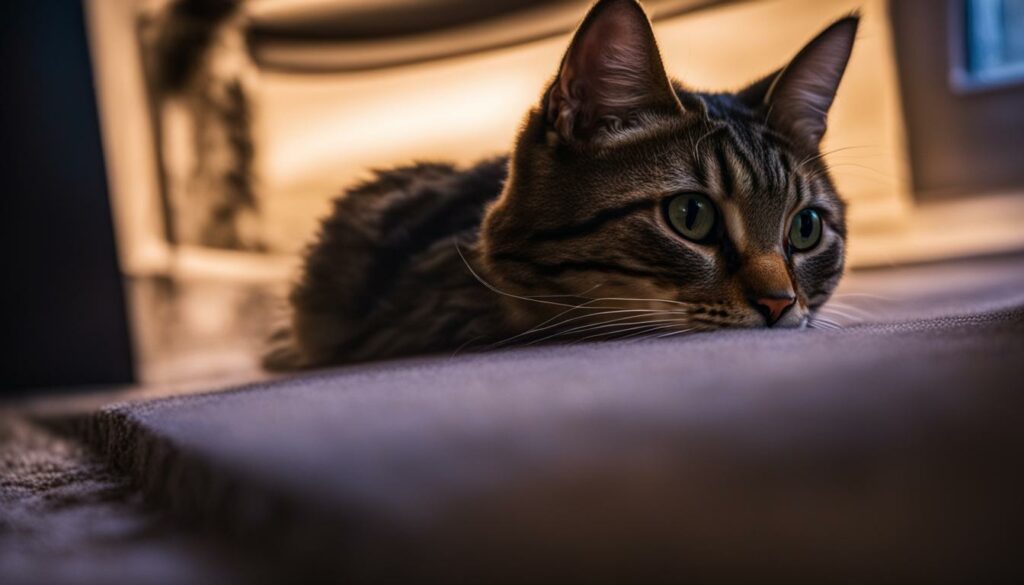
Steps to Make Your Cat Feel more Comfortable Around Ceiling Fans
Dealing with a cat’s fear of ceiling fans can be challenging, but with the right approach, you can help your furry friend feel more at ease. Here are some steps you can take to make your cat feel more comfortable around ceiling fans:
- Create a calm environment: Set up a designated safe space for your cat away from the fan. This can be a cozy corner with their bed, toys, and scratching post. Make sure the area is quiet and free from any potential stressors.
- Use positive reinforcement: Gradually introduce your cat to the presence of the fan. Start by turning it off and rewarding your cat with treats and praise for calm behavior. As they become more comfortable, gradually increase exposure by turning on the fan at a low speed.
- Experiment with visual alterations: Consider changing the color of the fan blades to minimize their resemblance to predators. This can help reduce your cat’s fear response. Some pet owners have found success with covers or stickers that match the color of the ceiling.
- Seek professional help if needed: If your cat’s fear persists despite your efforts, don’t hesitate to consult a professional cat behaviorist. They can provide expert guidance and develop a personalized plan to help your cat overcome their fear and anxiety.
Remember, every cat is unique, and it may take time for them to overcome their fear of ceiling fans. Be patient, provide plenty of reassurance, and celebrate small victories along the way. With your love and support, your cat can learn to feel more comfortable and safe in the presence of ceiling fans.
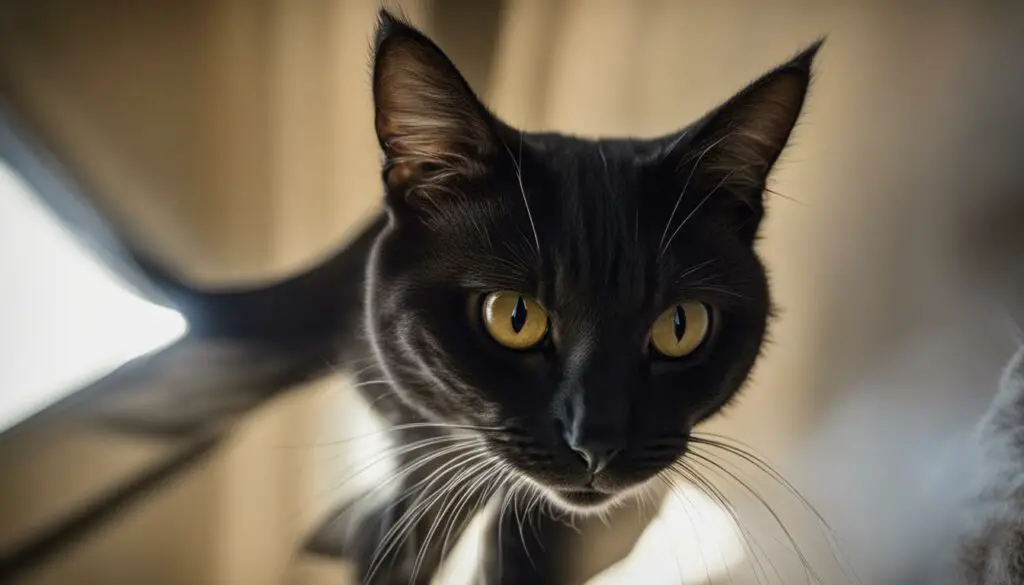
Tips for Creating a Safe Environment for Your Cat
Aside from helping your cat overcome their fear of ceiling fans, it’s crucial to create a safe and secure environment for them. Here are some additional tips to consider:
- Provide hiding places: Cats feel most secure when they have hiding spots to retreat to. Invest in cat trees, cardboard boxes, or cozy blankets where your cat can relax and feel protected.
- Avoid sudden noises and movements: Cats are sensitive to loud noises and sudden movements, which can startle and stress them. Keep the environment calm and predictable to help reduce their anxiety.
- Maintain a routine: Cats thrive on routine and predictability. Stick to a consistent schedule for feeding, playtime, and sleep. This stability can help reduce stress and create a sense of security.
- Consider calming aids: Calming pheromone sprays or diffusers can help create a soothing atmosphere for your cat. These products mimic natural feline pheromones, creating a sense of familiarity and comfort.
By implementing these strategies and providing a safe and supportive environment, you can help your cat navigate their fear of ceiling fans and create a peaceful space for them to thrive.
Things to Avoid When Helping Your Cat Overcome their Fear of Ceiling Fans
When it comes to helping your cat overcome their fear of ceiling fans, there are certain things you should avoid to ensure their well-being and success in the process. By understanding what not to do, you can create a supportive environment that promotes a positive and stress-free experience for your feline friend.
Avoid Forceful Methods
First and foremost, avoid using forceful or stressful methods when trying to help your cat overcome their fear of ceiling fans. Forcing your cat near the fan or punishing them for their fear will only increase their anxiety and make the situation worse. Instead, focus on creating a calm and safe environment, using positive reinforcement techniques, and allowing your cat to progress at their own pace.
“It’s important to remember that fear is a natural response for cats, and it’s our job as their caretakers to help them feel safe and secure.”
Don’t Rush the Process
Another thing to avoid is rushing the process of helping your cat overcome their fear. Each cat is unique and will require different amounts of time to feel comfortable around ceiling fans. Patience is key in this process, so be prepared to take it slow and allow your cat to gradually acclimate to the presence of the fan.
Avoid Overwhelming Your Cat
Lastly, it’s important to avoid overwhelming your cat during the desensitization process. Start with small steps, such as turning off the fan and introducing treats or playtime near it. As your cat becomes more comfortable, gradually increase their exposure to the fan by moving the blades manually or starting the fan at its lowest speed. Always gauge your cat’s comfort level and provide support and reassurance throughout the process.
By avoiding these common pitfalls and following a patient and positive approach, you can help your cat overcome their fear of ceiling fans and create a peaceful and anxiety-free environment for them.

| Things to Avoid When Helping Your Cat Overcome their Fear of Ceiling Fans |
|---|
| Avoid Forceful Methods |
| Don’t Rush the Process |
| Avoid Overwhelming Your Cat |
Frequently Asked Questions about Cats and Ceiling Fan Fear
As a cat owner, you may have questions about your feline friend’s fear of ceiling fans. Here are some frequently asked questions and answers to help you better understand and address this common issue:
1. Should I leave the ceiling fan on for my cat?
It is generally recommended to turn off the ceiling fan if your cat is scared of it. Leaving the fan on may heighten their anxiety and stress. Creating a calm environment by turning off the fan can help your cat feel more at ease.
2. Why is my cat staring at the ceiling fan?
When your cat stares at the ceiling fan, it may be a sign of curiosity or fear. Cats are naturally inquisitive, and the movement and sounds of the fan may grab their attention. However, if your cat appears tense or exhibits signs of fear, it is best to redirect their focus to something else to help alleviate their anxiety.
3. Why is your cat meowing at the fan?
Cats may meow at the ceiling fan as a way to express their distress or discomfort. They may be trying to communicate their fear or seek reassurance from their owner. It’s important to provide a safe and comforting environment for your cat and address their fear in a gentle and understanding manner.
4. How to remove ceiling fan phobia from a cat?
Removing ceiling fan phobia from a cat requires patience and gradual desensitization. Start by creating positive associations with the fan, such as offering treats or engaging in playtime near the fan. Gradually increase exposure to the fan, starting with it turned off and gradually turning it on at low speeds. Consistency and positive reinforcement can help your cat overcome their fear over time.
Remember, every cat is unique, and it may take time for them to feel comfortable around ceiling fans. If your cat’s fear persists or intensifies despite your efforts, consider consulting a professional cat behaviorist for further guidance and support.
Tips for Creating a Safe Environment for Your Cat
Creating a safe environment for your cat is essential, especially if they are frightened or anxious around ceiling fans. Here are some tips to help make your home a calm and secure space for your feline friend:
- Provide hiding places: Cats feel more secure when they have hiding spots to retreat to. Place cozy beds, cat trees, or enclosed spaces where your cat can feel safe and protected.
- Avoid loud noises: Cats are sensitive to loud or sudden noises, which can startle and stress them out. Try to minimize any loud sounds in your home, such as loud music or vacuuming, especially when your cat is already anxious.
- Maintain a consistent routine: Cats thrive on routine, so try to establish a consistent schedule for feeding, playtime, and social interaction. Predictability helps cats feel more secure and reduces anxiety.
- Provide enrichment activities: Keeping your cat mentally stimulated can help alleviate anxiety. Offer puzzle toys, scratching posts, and interactive play sessions to keep your cat engaged and entertained.
- Consider calming pheromones: Calming pheromone sprays or diffusers, such as Feliway, can help create a sense of security and calm in your home. These products mimic the natural pheromones that cats release when they feel safe and content.
By implementing these strategies, you can help your cat feel more comfortable and secure in your home, even if they have a fear of ceiling fans. Remember, every cat is unique, so be patient and observe their behavior to determine what works best for them.
| Pros | Cons |
|---|---|
| Creates a calm and secure environment | May require time and patience |
| Reduces stress and anxiety in cats | May need to make adjustments based on individual cat’s needs |
| Enhances overall well-being and happiness | May require additional resources or professional help in severe cases |
“Creating a safe environment for your cat is crucial in helping them overcome their fear of ceiling fans. By providing hiding places, minimizing loud noises, maintaining a routine, offering enrichment activities, and considering calming pheromones, you can create a peaceful and secure space for your feline companion.”
Expert Tip: Dr. Kate Smith, Certified Cat Behaviorist
“When helping your cat overcome their fear, it’s important to remember that their comfort and well-being should always be the top priority. Creating a safe environment is essential in building trust and reducing anxiety. Patience, consistency, and positive reinforcement are key in helping your cat feel more secure and confident in the presence of ceiling fans.”
Seeking Professional Help for Cats Afraid of Ceiling Fans
If your cat’s fear of ceiling fans persists or intensifies despite your efforts, it may be beneficial to seek professional help from a cat behaviorist. A behaviorist can assess your cat’s specific needs and develop a personalized behavior modification plan to help them overcome their fear. They can also provide guidance and support throughout the process to ensure the best possible outcome for your cat.
Professional assistance can be especially valuable in cases where your cat’s fear is severe or interfering with their daily life. A behaviorist can help identify the underlying causes of your cat’s phobia and recommend appropriate techniques and strategies to address it effectively. They have the expertise and experience to tailor a treatment plan that suits your cat’s individual personality, needs, and comfort levels.
When seeking professional help, it’s essential to choose a certified cat behaviorist who specializes in fear and phobias. Look for someone who has experience working with cats and a proven track record of success. You can ask your veterinarian for recommendations or search online for reputable behaviorists in your area.
Remember, seeking professional help is not a sign of failure or incompetence as a cat owner. It’s an acknowledgment that your cat’s well-being is a priority and that you are committed to helping them live a happy and stress-free life. With the right guidance and support, your cat can overcome their fear of ceiling fans and enjoy a more relaxed and comfortable environment.
Testimonials
“I was skeptical about seeking professional help for my cat’s fear of ceiling fans, but it turned out to be the best decision I made. The behaviorist not only helped my cat overcome their fear but also provided valuable insights into their overall behavior and well-being. I highly recommend seeking professional assistance if your cat is struggling with a similar issue.”
“I didn’t realize how deeply my cat’s fear of ceiling fans was affecting their quality of life until I consulted a behaviorist. The behavior modification plan they developed was tailored to my cat’s needs and progress was gradual but steady. I’m happy to say that my cat is now much more relaxed around ceiling fans, and it’s made a significant difference in their overall confidence and behavior.”

Gradual Progress and Success Stories
Overcoming fear of ceiling fans may seem like a daunting task, but with patience and persistence, many cat owners have successfully helped their feline companions conquer their fear. By employing gradual desensitization and positive reinforcement techniques, cats can gradually become more comfortable around ceiling fans. Here are a few success stories from cat owners who have achieved remarkable progress:
Coco’s Journey to Comfort
“When I first adopted Coco, she would hide under the bed at the mere sight of a ceiling fan. I knew I had to help her overcome her fear, but I also didn’t want to rush things. So, I started by turning off the fan and slowly introduced treats and playtime near it. As Coco began associating positive experiences with the fan, I gradually increased the exposure by moving the blades manually. Today, Coco not only sits calmly under the fan but even plays with the breeze it creates. It’s been an incredible journey seeing her overcome her fear!” – Sarah, Cat owner
Max’s Fear Turned into Curiosity
“Max used to run to the furthest corner of the room whenever the ceiling fan was turned on. I decided to try desensitization, starting with treats and toys near the fan. It took time, but gradually Max’s fear turned into curiosity. I would move the blades slowly and play with him nearby, reassuring him with gentle strokes and treats. Now, Max confidently explores the room, even sitting directly beneath the fan. It’s heartwarming to see him overcome his fear and realize that the fan is nothing to be scared of.” – Michael, Cat owner
These success stories highlight the power of patience, positive reinforcement, and gradual exposure when helping cats overcome their fear of ceiling fans. Each feline’s journey is unique, and progress may vary, but with love and support, you can help your cat feel more comfortable and secure in their environment.

Summary
Overcoming fear of ceiling fans requires a gentle and patient approach. By gradually introducing positive experiences, such as treats and playtime, and progressively increasing exposure to the fan, cats can learn to feel more comfortable and even curious about ceiling fans. Success stories from cat owners who have witnessed their cats overcome their fear serve as inspiration and motivation for those embarking on this journey. Remember, each cat is unique, so it’s important to adapt the approach to their specific needs and comfort levels. With consistent effort and a supportive environment, your cat can conquer their fear and enjoy a stress-free existence in the presence of ceiling fans.
Conclusion
Understanding and addressing your cat’s fear of ceiling fans is crucial for their well-being. Cats can develop this fear due to the fan’s movement, resemblance to predators, and unfamiliar sounds. However, with patience and the right techniques, you can help your cat overcome their fear and feel more comfortable in their environment.
By using desensitization and counter-conditioning methods, gradually introducing positive experiences, and altering the visual appearance of the fan blades, you can help your cat build a positive association with ceiling fans. Remember to respect your cat’s boundaries and never force them into uncomfortable situations.
Creating a safe environment, providing alternative sources of airflow, and seeking professional help if needed are all steps that can aid in your cat’s journey to overcoming their fear. Remember, every cat is unique, so it’s important to tailor your approach to their specific needs.
With your love, support, and understanding, your cat can conquer their fear of ceiling fans, leading to a happier, more relaxed, and stress-free life for both of you.
FAQ
Should I leave the ceiling fan on for my cat?
It is best to observe your cat’s behavior and comfort level. If they show signs of fear or discomfort, it may be better to keep the fan off or provide alternative sources of airflow.
Why is my cat staring at the ceiling fan?
Cats are naturally curious creatures, and they may be fascinated by the movement and sound of the fan. However, if your cat shows signs of fear or stress, it is important to address their discomfort.
Why is your cat meowing at the fan?
Cats may vocalize when they are feeling anxious or scared. Meowing at the fan could be a way for your cat to communicate their fear or attempt to ward off the perceived threat.
How to remove ceiling fan phobia from a cat?
Overcoming your cat’s fear of ceiling fans requires patience and positive reinforcement. Gradual exposure, desensitization, and counter-conditioning techniques can help your cat feel more comfortable around ceiling fans. Seeking the assistance of a professional cat behaviorist may also be beneficial.
Source Links
- https://be.chewy.com/my-cat-fears-the-ceiling-fan/
- https://excitedcats.com/why-cat-afraid-of-ceiling-fan/
- https://learnaboutcat.com/cat-afraid-of-ceiling-fan/

